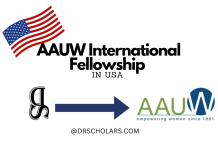KAIST scholarship is a university-based fully funded scholarship offered to international students from around the world.
This a good opportunity for Undergraduates & Graduates who are interested to study in Korea.
Most students have queries about KAIST requirements and its eligibility criteria,
Some face problems while writing a “Statement for purpose” for KAIST.
This KAIST scholarship guide is as detailed as it gets. It will explain everything in a simplistic way for Graduate applicants.
After reading this KAIST guide, Students will not only learn how to find courses and the step-by-step Kaist application process but they will also stand out & outshine everyone.
Don’t miss the Frequently asked questions at the end.
If you want to study in Germany for free, find out our detailed guide about DAAD scholarship.
KAIST SCHOLARSHIP
1. Benefits of Kaist Scholarship
2. Eligibility Criteria for KAIST scholarship
3. What are the documents required for KAIST
4. How to apply for KAIST Scholarship
5. How to find Courses for KAIST Graduate Applicants
6. Deadlines of KAIST Graduate Scholarship
Undergraduate applicants of KAISt can find their detailed guide here.
1. Benefits of KAIST scholarship
- The tuition fee will be fully covered. (Which could be thousands of USD for self-sponsored students).
2. Monthly stipends of KRW 350,000 (267 USD) for Master’s students and KRW 400,000 (306 USD) for Doctoral students will be given.
3. Health insurance premiums offered by Programs & Advisors. (Which could be more than 1200 USD for Self-sponsored students).
4. Additional income could be given on the basis of research participation etc
-According to KAIST university official statistics Almost 94% of international students get the KASIT scholarship.
2. Eligibility Criteria for KAIST scholarship
Eligibility criteria of Kaist is very simple,
- Citizens of every country are eligible for Kaist scholarship, except Korean citizens. they have to make a Certificate of the Facts. Click here for more details.
- Academic documents & transcripts should be ready until August 28th, 2023. Find details here.
- There is a requirement for an English proficiency test, that could be fulfilled by providing IELTS (6.5) or TOFEL ( 83). However, if you are from Pakistan, India, Ghana, Sudan, UK, USA, & your taught language was English, then you can provide an English proficiency certificate. Find details here.
- Before applying for KAIST scholarship, Contacting with the Faculty member is requirement for few courses. Find out here.
Here is our detailed guide about Great scholarships UK.
3. What are the documents required for KAIST
1. Filled & signed Application for KAIST scholarship
3. Hope certificate (Optional)
6. EPT (IELTS or TOFEL) [If applicable]
7. Passport [& Birth certificates]
8. Certificate of family registration
9. The Certificate of the Facts (Only for Korean Ethnic students)
10. Equivalency certificates (if applicable)
11. Research proposal (Optional)
12. Experience letter (Optional)
14. Portfolios or workshops (in some cases)
3.1. Filled & signed application of KAIST
- Undergraduate & graduate students can find their Kaist application form here.
- Pay the fee of the KAIST scholarship application KRW 80000 (80 USD).
- Print it out, sign it, and Be careful while filling out the application, because it can’t be edited once the fee is paid.
3.2. Academic documents
This includes all your certificates & academic record like
A: Bachelor’s transcript & certificate (If a student is applying for a master’s)
B: Master’s transcript & certificate (if the student is applying for Ph.D.)
C: Metric & FSC transcripts (10-12th Grade) (A level) (DMCs) and certificates (if the student is applying for Bachelor)
D: Course summary (to explain your courses & how your previous courses & studies resemble your future studies in which you are applying)
The documents must be translated into English if the original language is not in English.
Remember if students want to apply for the 2023 KAIST scholarship the above documents should be ready by August 28th, 2023.
NOTE:
All the above documents & their photocopies should be attested by respective boards, issuing authorities, or respective universities.
Remember photocopies that are not verified will not be accepted by Kaist.
In case of Pakistan The above-mentioned documents must be attested by IBCC, HEC, and MOFA (Ministry of Foreign Affairs).
IBCC authority is only responsible for the attestation of metric and inter documents.
Dear offices are present in Peshawar, Karachi, Lahore, Islamabad, and also in other cities of Pakistan.
HEC office attests bachelor’s, master’s, and Ph.D. documents.
Other countries need to attest their documents from the respective local ministries & authorities.
3.3 HOPE CERTIFICATE: (If applicable)
Hope certificate which is also known as an “Expected graduation letter” could be submitted in that case if the applicant doesn’t have their final degrees at the time of submitting their KAIST application.
What is Hope certificate?
In simple words, It is a certificate based on the previous semester’s performance, that indicates that the candidate will pass the final exams with excellent results.
Hope certificate must mention all the applicant details & expected Date of graduation.
Sometimes, Korean universities’ admission process takes time due to the huge number of applicants from around the world. Students can get their final degrees by then.
3.4. Letter of Recommendations
Unlike DAAD and Chevening scholarships, the applicant can’t submit directly the recommendation letters for KAIST.
Instead, they will provide the detail of their referees & university will contact them on Applicant’s behalf.
When students pay the application fee KRW 80000 (80 USD), The referee will get an automated email after that.
Remember these recommendation letters will not be disclosed to the applicant.
NOTE:
It is advised to provide the details of your HOD (Head of the department or Relevant course head) which should be a PHD.
The letter must include an official letterhead, signature, and official stamp and must be of the current date.
Ask your Referees to write about your academic achievements & discuss their confidence in you that you are fully compatible with the project or course you wish to pursue through KAIST scholarship.
3.5. CV
Europass CV can be easily made here.
The Cv must contain all the latest & relevant information about your occupation, Academics & interests.
A perfect CV must be hand signed.
3.6. EPT [IELTS or TOFEL] (If applicable)
Technically, Most international students will need EPT (English proficiency test) scores.
It could be in the form of IELTS or TOEFL.
IELTS minimum score (In academic mode) for the KAIST scholarship is 6.5 band,
while For TOFEL 83 (560*/220) is the minimum eligible score.
Other English testing certificates are also accepted like TOEIC, and TEPS but the “Institutional Testing Program” (ITP) is not accepted.
Citizens of countries like India, Pakistan, USA, UK, Ghana, Sudan, Nigeria etc are excluded to show EPT scores if their medium of taught courses was English. (Means their degrees were conducted in English)
However, they still need to provide an English proficiency certificate. Check more detail here.
It is still advised to these students to do the IELTS or Tofel, it will certainly increase their chances to get The KAIST scholarship.
3.7. Passport (& Birth certificates):
Passport & Birth certificate (identity documents) of the applicant & both of their parents are necessary to find out their nationality which is very important for the eligibility of the KAIST scholarship.
Those students who are Korean or one of their parents is Korean or have dual Korean citizenships are NOT eligible for the KAIST scholarship.
3.8. Certificate of Family Registration:
It could be shown in the form of providing Birth certificates or FRC (Family registration certificates).
This document specifically contains the names & information of your siblings & parents. (or spouse in some cases).
International Students should consult their local authorities/ministries to get their family registration certificate.
If you are a student from Pakistan, then a Family registration certificate (FRC) is issued by NADRA offices in Pakistan. The applicant can also apply for it online.
3.9. The Certificate of the Facts: (Only for Korean Ethnic students)
Those Korean Ethnic students who completed their entire education (School & High school ) outside Korea, or
both of their parents who renounce Korean citizenship are eligible for the KAIST scholarship but must provide the Certificate of the Facts Concerning the Entry & Exit (“출입국사실증명서”) issued by the Korean Immigration Office and official certificates.
Letters of Primary & secondary school completion are also necessary.
3.10. Equivalency certificates: (If applicable)
In simple words, Equivalency certificates actually analyze the years of education a student has, for eligibility of applied courses.
Generally, a University degree requires four years of study
OR
– Three-year Bologna-compliant Bachelor’s degree
OR
-Bachelor’s degree with honors in British pattern education
OR
-EHEA.
If Applicants have any doubt that their degree does not fulfill the above criteria of KAIST, Then they need to provide Equivalency certificates.
Here is the best way to check it.
Check the screenshot

Students can apply for the Equivalency certificates to Kaist Scholarship through KARIC.
Remember, most of international students already fulfill the academic criteria, so they don’t need to provide any Equivalency certificates.
3.11. Research Proposal (Optional)
The research proposal is mostly required for postdocs or PHD students. (Depend upon the courses)
It asks you to write about the research project you agree upon completing with the assigned academic advisor.
Your research proposal should be a brief description of your research goals and objectives, the methods with which you wish to process that research, the outcomes you desire, the timeline and budget you have estimated, and the area of study you wish upon exploring.
It shall be a brief document yet explain the entire vision to the reader so that those analyzing your application could know of your objectives and grant you the scholarship if they match the program’s criteria and eligibility.
Taking help from an external party is strictly prohibited and violation in this regard could lead to your disqualification no matter how incredible your proposal is.
3.12. Experience letter (Optional)
Applicant can provide Experience letter of the previous jobs & Internships.
Try to customize the work experience letter with future studies.
Mention your job descriptions, work projects & the skills you learned through time.
The letter must be signed & verified by the Head or CEO of the company.
3.13. University application
It sounds obvious. To get the benefits of KAIST scholarship, the applicant must choose specific courses at KAIST university.
3.14. Portfolios or workshops (in some cases)
In some particular cases like “Architecture”, the applicant can submit portfolios of their work.
TIP: Always ask the International Office of KAIST university whether you need to fulfill the portfolio requirements or not.
because at the end their committee will decide your application.
3.15 Statement of purpose for KAIST Scholarship:
SOP is compulsory for the KAIST scholarship. Students are required to write (max 5000 words) to present their case in the most authentic detailed way possible.
In SOP, you have to write about your personal and professional reasons why are you applying for the course & the scholarship.
How to write a perfect statement of Purpose for KAIST?
If you are interested in writing your SOP concisely, then follow this exact method.
SOP consists of three parts.
3.15.1. Introduction (one paragraph)
3.15.3 Conclusion (1 paragraph)
Let’s explain these three things one by one.
3.15.1. Introduction:
The introduction is the gateway to the rest of the SOP. Try to capture their interest in the first few sentences. Be original & creative.
Make it personal & full of enthusiasm.
TIP: Try to initiate a story about yourself relevant to the scholarship you are applying for & then expand it to the first paragraph of the body.
3.15.2. Body:
In the first paragraph of the body, try to tell about your relevant academic & experienced background to the course.
And your professional goals attached to the Korea & KAIST Scholarship. Share your expectations of the scholarship.
In the 2nd paragraph be more precise & focus on the specific achievement related to the scholarship & course.
In the 3rd paragraph expand on what you are currently doing & the interesting things you look forward to.
3.15.3. Conclusion:
Tell them why you are the best candidate for KAIST scholarship. Don’t sound needy or use pompous language instead focus on why you deserve it.
Tell them how this scholarship will help you or the future of your community.
Tips for Statement of Purpose (SOP)
- Don’t repeat what you have already written in your CV introduction or Cover letter. Try to capture their interest in the first paragraph.
- Try to stick to one theme, don’t jump around ideas. Be specific.
- Technically, It shouldn’t cross 5000 words. In fact, I will advise you to write it very concisely. Share ideas shortly, you will later have time to expand on them in an interview.(If contacted)
- Apply an appropriate style of writing. It could be a little informal but factual. Somewhere in between academic & informal, but avoid flattery, verbose & bombast language & phrases.
- Do not campaign for your beliefs.
- Proofread the text and delete all dispensable and redundant parts. In the end, your statement of purpose should comprise not more than two thousand words.
If you want to study in the UK for free, find out our detailed guides about Chevening and Commonwealth scholarships.
4. How to apply for KAIST scholarship:
Here are the six simple steps to apply for KAIST scholarship.
4.1. Make an Account at KAIST
Undergraduate & graduate students can find their Kaist application form here.
4.2. Prepare the documents
Prepare the set of 15 documents we discussed above in detail. Click here to find out.
4.3. Prepare your SOP And Six questions
A: Prepare your SOP (statement of purpose), as we discussed above.
B: prepare to answer the following six questions
1. What you studied at the previous institution?
2. Motivation for applying for the major?
3. Brief study plan
4. Future plan after study
5. Honors and awards
6. Introduction of the institution previously attended
4.4. Check if your courses allow you to search for an advisor
At Master’s level, Most Kaist courses don’t require you to communicate with any faculty members.
The applicant just has to write the names of the three Faculty members in their Kaist application whose research attract them more Or is aligned with their future academic ambitions.
However, there could be a few courses in Masters or MS integrated with PHD or Doctorate courses where Applicant are required to contact the Faculty member & take their advice before applying.
Students must mention the names of the faculty members in their KAIST application.
Students can find out about the courses here.
4.5. Fill in the financial details
A: International students who are applying for KAIST scholarship, select “Kaist scholarship” in financial resources.
B: If students get any other scholarship (Government, organizational), select that.
C: If Applicant is self-financed or sponsored by parents then mention the resources, That how they will be able to afford it.
They need to show a balance of 18,000 USD.
4.6. Submit the Application
After filing your Academic & personal details perfectly, Pay the fee of the KAIST scholarship application KRW 80000 (80 USD).
Print it out, sign it, and Be careful while filling out the application, because it can’t be edited once the fee is paid.
Check your email & portal regularly for future instruction. Check if you need to post your Kaist application to KAIST office. Find Kaist contact here.
5. How to find courses for KAIST Scholarship
There are two main KAIST campuses.
Daejeon Campus (Main campus)
and
Seoul Campus.
All the courses for (Masters, PHD, Masters integrated with PHD) with their official links & degrees are given below in the table.
|
Programs |
Availability |
Contact info |
|
Physics |
-Masters to phd |
|
|
Mathematical Sciences |
-Masters |
|
|
Chemistry |
-Masters to phd |
|
|
Biological Sciences |
-Masters to phd |
|
|
Medical Science and Engineering |
-Masters to phd |
|
|
Mechanical Engineering |
-Masters |
|
|
Aerospace Engineering |
-Masters |
|
|
Electrical Engineering |
-Masters |
|
|
The Robotics Program |
-Masters |
|
|
School of Computing |
-Masters |
|
|
Graduate School of Information Security |
-Masters |
|
|
The Kim Jaechul Graduate School of Artificial Intelligence |
-Masters |
|
|
Civil and Environmental Engineering |
-Masters |
|
|
Bio and Brain Engineering |
-Masters |
|
|
Industrial Design |
-Masters |
|
|
Industrial & Systems Engineering |
-Masters |
|
|
– Graduate School of Data Science |
-Masters |
|
|
Chemical and Biomolecular Engineering |
-Masters |
|
|
Materials Science & Engineering |
-Masters |
|
|
Nuclear and Quantum Engineering |
-Masters |
|
|
Graduate School of Culture Technology |
-Masters |
|
|
Graduate School of Science and Technology Policy |
-Masters |
|
|
Business and Technology Management |
-Masters |
|
|
Graduate School of Global Digital Innovation (GDI) |
-Masters |
|
|
KAIST MBA |
-Masters |
If you want to study in Italy for free, find out our detailed guides about DSU and EDISU scholarships.
6. KAIST Scholarship Deadline for Graduates
|
Kaist Graduate Scholarship |
Application Deadline |
Application Materials arrive at KAIST |
|
Early track |
Dec 1 – Dec 22, 2022 |
Jan 2-2023 |
|
Regular Track |
Feb. 28 – Mar 22, |
April-3-2023 |
Official deadline link for regular track
Official deadline link for early track
7. KAIST contact for Graduate Applicants
Postal Address:
Graduate Admissions Team, KAIST # 110, 1st Floor, E 16-1 B/D 291 Daehak-ro, Yuseong-gu, Daejeon
(Zip Code: 34141) Republic of Korea
Office: +82-42-350-2352, 2354
E-mail: advanced.adm@kaist.ac.kr
8. FAQS about KAIST Scholarship
Q: Are Equivalency certificates compulsory for KAIST Scholarship?
NO. it’s not compulsory for every applicant. It’s only required for applicants who don’t fulfill any of the following criteria:
–If the applicant doesn’t have a University degree (which requires four years of study)
OR
– Three-year Bologna-compliant Bachelor’s degree
OR
-Bachelor’s degree with honors in British pattern education
OR
–EHEA.
Students can apply for the Equivalency certificates to Kaist Scholarship through KARIC.
Q: Can I submit the photocopies of my degree & transcript for KAIST application?
Only those documents & their photocopies are accepted by KAIST, which are attested by respective boards, issuing authorities, or universities.
Remember photocopies that are not verified will not be accepted by KAIST.
Q: Can I apply with the 7th-semester transcript to a KAIST university?
Yes, you can. By getting a “Hope certificate” from the university.
Hope certificate which is also known as an “Expected graduation letter” could be submitted in that case if the applicant doesn’t have their final degrees at the time of submitting their KAIST application.
Students can attach the “Hope certificate” along with all the academic documents & fill out the admission application.
Q: IS IELTS or TOEFL required for KAIST scholarship?
Technically YES. However, citizens of a few countries can be exempted from this requirement. & can produce English proficiency certificate if the medium of teaching in their universities was English.
These countries include:
Botswana, Cameroon, Eswatini, Ethiopia, Fiji, Gambia, Ghana, India, Jamaica, Kenya, Kiribati, Lesotho, Liberia, Malawi, Marshall Islands, Mauritius, Federated States of Micronesia, Namibia, Nauru, Nigeria, Pakistan, Palau, Papua New Guinea, Philippines, Rwanda, Samoa, Seychelles, Sierra Leone, Singapore, Solomon Islands, Republic of South Africa, Sudan, Republic of South Sudan, Tanzania, Tonga, Tuvalu, Uganda, Vanuatu, Zambia, Zimbabwe
Antigua and Barbuda, Australia, the Bahamas, Barbados, Belize, Canada, Dominica, Grenada, Guyana, Ireland, Jamaica, Malta, New Zealand, St Kitts, St Lucia, St Vincent, Trinidad and Tobago, U.K., U.S.A.
Having IELTS & TOEFL scores can definitely give benefits in Kaist Evaluation.
Q: What is the method of selection for the KAIST Scholarship?
The benefits & coverage provided by KAIST scholarships mostly depend on two factors.
1. Applicant’s Academic record
2. Applicant’s future potential [Which can be explained through SOP (Statement of purpose)] & Six questions in the application form.
The financial benefits of the KAIST scholarship will be prolonged if the student carries on an extraordinary performance in academics & research.
Q: Is KAIST scholarship, easy to get?
According to KAIST university official statistics, Almost 94% of international students get the KASIT scholarship.
Q: How many degree programs you can apply for KAIST?
Ans: You can apply to the only one-degree program at each application term.
Q: Is it compulsory to communicate with the Faculty members while applying for KAIST scholarship?
It depends on the courses. Communicating with faculty members is compulsory for Master’s to phd integrated programs & Doctorate programs.
It is also compulsory for a few Master’s courses.
However, in most Master’s programs, students are only required to write the names of three faculty members whose Academic research aligns with their interests.












Hello, please advice me whether I need to provide an A LEVEL Certificate or it just an optional as my school is base on English teaching program.